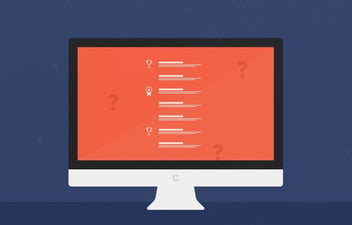The start of any
new application or
software development project is an exciting time. However, it can also be daunting as you wonder if the project will catch on. Many of our customers ask us, “Do you think people will like this new feature?” or “You think users will like this?”.
As much as we’d love to tell everyone that yes their genius idea is going to work, there is much more that goes into it.
The specific product features, such an those in a
healthcare mobile app development, will generate value in your particular project are highly dependent on your industry and the goals of the project. Often something amazing can be built, but it doesn’t mean that people will use it. As an expert in your own field, you must take on that task yourself to determine if the tool you intend to create is beneficial and will be used.
We can, however, give you tools to help you outline and communicate that value for yourself, your organization and your suppliers.
Step 1: Identify a Problem
The very first action to take is to identify an issue with your current process, one that can be solved or optimized by a mobile application. This can be any number of different things including better reporting, improved patient experience or streamlining communication through different teams, departments or stakeholders.
The essence of any great application or feature is not the slick, innovative design - although it definitely helps. It comes down to the value that is being provided.
Value is generated with simple solutions to tangible problems. Simple solutions, in turn, are based on a clear vision and the ability to eliminate unnecessary features. Simplicity is a demanding art form, but more often than not, it will maximize your return on investment. Apple is a great example of cashing in on simplicity. Their products are more expensive and less complex than those of their competitors, and yet they are turning a huge profit.
Basecamp, a web development company renowned for the usability of its software, has a policy of rejecting every new feature request offhand. They only begin to consider implementing new features after they have been suggested by multiple sources.
New York Times technology journalist David Pogue’s lifehack for all project managers is: “Whenever a programmer asks you whether a new feature should be added, your tasks is to say no!”
Before you begin to ponder the value of your product or its features, you should define the problems you intend to solve in either your software product or
ecommerce store. This problem definition by Airbnb, a company revolutionizing the world of accommodation services, is a great example:
- Price is an important concern for customers booking travel online.
- Hotels leave you disconnected from the city and its culture.
- No easy way exists to book a room with a local or become a host.
At the end of the day, trying to solve a problem and really understanding a problem comes down to who. If you know who is having a certain issue then it helps lead you to create an application that has the solution.
This leads us to step 2.
Step 2: Define your Target Audience & Users
The success of any application comes down to a thorough understanding of its target audience and users. Depending on the application, there may be different user groups who will use the very same app for differing reasons. This means that certain features will be very important for some of your users and irrelevant for others.
What this all means is that you will truly need to understand your users. And understanding your users means that you realize that those people using your application all don’t look the same, don’t act the same and use your app the same.
Many mobile apps go wrong because they generalize all their users to 1 group and make all their decisions and upgrades based on this. However, this ignores many users who have unique needs and use cases for your mobile app.
Don’t assume that you know exactly what your users want. At Vincit, we always encourage getting down and dirty with talking to real-life users and getting a deep understanding of what they are looking for in the mobile app and what improvements they want to see.
Mobile applications that allow individual user groups a streamlined and optimized experience will encourage more adoption and downloads. Apps that frustrate users and fall short of delivering the optimal experience will cause frustration and drop off of users. In the long term, delivering the wrong things for your users will lead to more frequently needed upgrades and additional work to course correct. This reinforces the importance of doing the due diligence in the beginning, knowing the problem and knowing your user base and what they need.
Bottom line: when researching the target audience make sure to engage all users, add the functionality they want and need, and optimize the user experience from their point of view.
Step 3: A Good Elevator Pitch
How do you initiate conversation when you contact a potential supplier? Do you hand them a wish list of features and give the desired starting date?
How about starting your request for quotation with an elevator pitch that tells the supplier why your product is a winner? This way, all operations are based on the value generated for the user, and the supplier is able to better assess their ability to meet your needs. Elevator pitches inspire and engage the supplier in your project from the get-go.
A great elevator pitch is an asset in internal and external communications, helping you focus on the essentials. You can also draw a hypothetical physical package for your product and think about the features you’d highlight on the package. A good elevator pitch answers these key questions:
- Who is the product made for?
- What needs does it address?
- What category does it belong to?
- How does it benefit its users?
- What sets it apart from other similar products?
- What is the key differentiator?
- Why should users choose your product over others?
Step 4: Mapping Technological and Compliance Requirements
Mobile applications do not live in a vacuum. They are built to help businesses expand their offerings to customers and create more touch points to interact with their customers. All of this means that your mobile will live in your business’s ecosystem.
What does that mean? Well that your mobile app will have to integrate with all the software and technology that your business relies on. This can include:
- POS integrations
- Payment integrations
- CRM integrations
- Analytics integrations
- Accounting integrations
- Marketing integrations
- Customer support integrations
Each business will have it’s own integrations that it will need in order to have the mobile app truly work in conjunction with the current operations and technology of the business. Before development of the mobile app, understanding the mapping and technological needs of the application in a business’s technology ecosystem is vital to the ultimate success of the app and its’ value to the business.
In addition, some industries have compliance laws that they must follow. For example, in the healthcare and medical industries strict regulations are enacted with HIPAA. Healthcare institutions are privy to private and sensitive data and as the world continues to digitize, that means the security of data must also be digitized. Therefore, mobile health applications must meet regulations and compliance laws with the federal government.
Therefore, when mapping out your application, understand the technological requirements alongside any regulatory or compliance standards will unearth all the boxes that must be checked in creating an application that can live in the market.
Step 5: Designing the UI/UX Experience
The design process of a mobile application should keep simplicity as its guiding light. Here is where an application will come into life, it’s design, it’s mockups and really the overall experience. Ensure that at this point that you map out a concise navigational structure that doesn’t cause confusion or make things hard to find. Use basic colors and legible fonts to not make things too noisy.
At this point in the
custom mobile app development process is where excitement and eagerness can derail a project. Trying to make things jump and really over emphasising designs can look great on paper - or screen - but they can create long term headaches.
Straightforward designs make for simpler development and lay the groundwork for an organized and simple ecosystem that can be updated. An easy frameworks is conducive to agile and quick upgrades and developments. That way as new features need to be added or user suggestions are implemented, they can be done quickly and easily.
Mobile applications that are too heavy on design can create a framework that is bulky and difficult to work with. And one of the most important aspects of a success of an app is continually upgrading it and its features. Failing to do so can result in a mobile app that slowly becomes obsolete with users who leave. And once users leave, it’s extremely difficult to get them to come back.
Service and UX Designers
Users demand services with great usability and visual style. Make sure that the team you’ve assembled uses both service designers and
UX (user experience) designers, in-house or as partners.
Service designers work in close cooperation with clients, end-users, and the development team. Their job is to ensure that the application design caters to end-users’ needs and to help the client develop their business model. The latter is called business design. Using methods like workshops and facilitation, service designers help you design world-class services.
UX designers ensure that the
UX strategy is both easy to use, and easy on the eyes. This entails all the elements that are visible to the end-user. The terminology is still evolving, and you might also come across terms such as UI or CX design (user interface/customer experience). Before your project starts, make sure that you understand your supplier’s approach - and that they are doing the right things.
If you're looking for a partner in UX design or a highly-rated customer experience agency, Vincit is an excellent choice. Our team of experts can help ensure that your UX strategy is not only user-friendly and visually appealing but also aligned with your business goals.
Step 6: Development of a Minimum Viable Product
A minimum viable product (MVP) is an early version of your product which is developed with just enough features to validate the problem and its solution in practice. MVPs are used to collect, and learn from, analytics data and feedback from real users. A successful software development project often starts with an MVP phase.
The first version of your product to be introduced in the market can be built around that same functionality. An MVP consists of the key features that resonate with users and make the product stand out from the competition.
MVP functionality sets a good foundation for your RFQ and you should review it with your supplier in detail. This way value generation forms the bedrock of your project. It is also important to discuss other features and potential future development plans.
It might be worthwhile to impose a deadline for the MVP development process. This forces you to carefully reflect on the core functions of your product or service.
On the other hand, an MVP should also include the parts of the project that entail the highest risk. Risky entities are usually pushed back to the later phases of development projects, when in fact they are the very features that often set the product apart and generate the most value.
“I love complex software,” said no one ever. But designing simple and intuitive products is difficult.
As mathematician Blaise Pascal once quipped: “If I had more time, I would have written a shorter letter”. This statement neatly embodies the paradox of simplicity: developing easy to use technology is hard while creating complicated technology is easy. Instead of developing software that comes with a thousand-page-long manual, we recommend designing products that don’t need instructions. Users will let you know what they want (everything!) but it’s vital that you figure out what they actually need.
Step 7: Test and Iterate
Once an MVP has been developed is when the mobile application you built will have life and start to grow and evolve. Developing an application never truly ends. It is a constant cycle of building, testing and iterating.
This is where much frustration comes from businesses. They think an application is a 1 time project that once finished will be the end of development.
The best applications need continual refinement and improvements to continue to create an experience and value proposition that users will continually flock to. A good parallel comparison is websites. Websites now are arguable one of the most important assets to businesses. Sites need to be constantly updated, maintained and grown.
Mobile applications are no different.
As the app lives, you’ll want to have signals and surveys out that help identify areas of improvements. User feedback and analytics are vital in detecting unforeseen issues and oversights. These inform future upgrades and developments while also just continuing to create a mobile app that continually refines the user experience.
Conclusion
As you can see, there is a lot that goes into any mobile app project and its eventual success. However, with the steps above, it will help organize an otherwise complex and overwhelming process. There is nothing you can do to absolutely guarantee adoption or success, but follow the principles above when developing your mobile app and you will greatly improve your chances!



